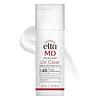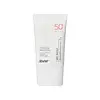What's inside
What's inside
 Key Ingredients
Key Ingredients

 Benefits
Benefits

 Concerns
Concerns

 Ingredients Side-by-side
Ingredients Side-by-side

Zinc Oxide 9%
Cosmetic ColorantEthylhexyl Methoxycinnamate 7.5%
UV AbsorberWater
Skin ConditioningCyclopentasiloxane
EmollientNiacinamide
SmoothingOctyldodecyl Neopentanoate
EmollientHydroxyethyl Acrylate/Sodium Acryloyldimethyl Taurate Copolymer
Emulsion StabilisingButylene Glycol
HumectantPhenoxyethanol
PreservativePolyisobutene
Triethoxycaprylylsilane
Tocopheryl Acetate
AntioxidantPEG-7 Trimethylolpropane Coconut Ether
EmulsifyingOleth-3 Phosphate
Iodopropynyl Butylcarbamate
PreservativeLactic Acid
BufferingSodium Hyaluronate
HumectantPhosphoric Acid
BufferingZinc Oxide 9%, Ethylhexyl Methoxycinnamate 7.5%, Water, Cyclopentasiloxane, Niacinamide, Octyldodecyl Neopentanoate, Hydroxyethyl Acrylate/Sodium Acryloyldimethyl Taurate Copolymer, Butylene Glycol, Phenoxyethanol, Polyisobutene, Triethoxycaprylylsilane, Tocopheryl Acetate, PEG-7 Trimethylolpropane Coconut Ether, Oleth-3 Phosphate, Iodopropynyl Butylcarbamate, Lactic Acid, Sodium Hyaluronate, Phosphoric Acid
Water
Skin ConditioningCyclopentasiloxane
EmollientEthylhexyl Methoxycinnamate
UV AbsorberGlycerin
HumectantTitanium Dioxide
Cosmetic Colorant4-Methylbenzylidene Camphor
UV AbsorberButyl Methoxydibenzoylmethane
UV AbsorberEthylhexyl Salicylate
UV AbsorberOctocrylene
UV AbsorberSilica
AbrasiveEthylhexyl Ethylhexanoate
EmollientGlyceryl Stearate
EmollientPEG-100 Stearate
Cetearyl Alcohol
EmollientPolysorbate 80
EmulsifyingTriceteareth-4 Phosphate
EmulsifyingPotassium Cetyl Phosphate
EmulsifyingPEG-2 Stearate
EmulsifyingHydroxyacetophenone
AntioxidantGlycol Stearate
EmollientCarbomer
Emulsion StabilisingTromethamine
BufferingParfum
MaskingDimethicone
EmollientEthylhexylglycerin
Skin ConditioningIsotridecyl Isononanoate
EmollientCI 77492
Cosmetic ColorantDisodium EDTA
Sodium Stearoyl Glutamate
CleansingCI 77491
Cosmetic Colorant1,2-Hexanediol
Skin ConditioningLauryl PEG-10 Tris(Trimethylsiloxy)Silylethyl Dimethicone
EmulsifyingTriethoxycaprylylsilane
Sodium Hyaluronate
HumectantJasminum Officinale Flower Extract
MaskingGossypium Herbaceum Extract
Skin ConditioningButylene Glycol
HumectantTocopherol
AntioxidantRobinia Pseudoacacia Flower Extract
Skin ConditioningLilium Tigrinum Extract
Skin ConditioningLilium Tigrinum Flower/Leaf/Stem Extract
Skin ConditioningNymphaea Alba Flower Extract
Skin ConditioningBenzyl Salicylate
PerfumingGeraniol
PerfumingHexyl Cinnamal
PerfumingButylphenyl Methylpropional
PerfumingLimonene
PerfumingLinalool
PerfumingWater, Cyclopentasiloxane, Ethylhexyl Methoxycinnamate, Glycerin, Titanium Dioxide, 4-Methylbenzylidene Camphor, Butyl Methoxydibenzoylmethane, Ethylhexyl Salicylate, Octocrylene, Silica, Ethylhexyl Ethylhexanoate, Glyceryl Stearate, PEG-100 Stearate, Cetearyl Alcohol, Polysorbate 80, Triceteareth-4 Phosphate, Potassium Cetyl Phosphate, PEG-2 Stearate, Hydroxyacetophenone, Glycol Stearate, Carbomer, Tromethamine, Parfum, Dimethicone, Ethylhexylglycerin, Isotridecyl Isononanoate, CI 77492, Disodium EDTA, Sodium Stearoyl Glutamate, CI 77491, 1,2-Hexanediol, Lauryl PEG-10 Tris(Trimethylsiloxy)Silylethyl Dimethicone, Triethoxycaprylylsilane, Sodium Hyaluronate, Jasminum Officinale Flower Extract, Gossypium Herbaceum Extract, Butylene Glycol, Tocopherol, Robinia Pseudoacacia Flower Extract, Lilium Tigrinum Extract, Lilium Tigrinum Flower/Leaf/Stem Extract, Nymphaea Alba Flower Extract, Benzyl Salicylate, Geraniol, Hexyl Cinnamal, Butylphenyl Methylpropional, Limonene, Linalool
 Reviews
Reviews

Ingredients Explained
These ingredients are found in both products.
Ingredients higher up in an ingredient list are typically present in a larger amount.
Butylene Glycol (or BG) is used within cosmetic products for a few different reasons:
Overall, Butylene Glycol is a safe and well-rounded ingredient that works well with other ingredients.
Though this ingredient works well with most skin types, some people with sensitive skin may experience a reaction such as allergic rashes, closed comedones, or itchiness.
Learn more about Butylene GlycolCyclopentasiloxane, or D5, is a silicone used to improve texture of products and trap moisture.
D5 is considered lightweight and volatile. Volatile means it evaporates quickly after application. Once evaporated, D5 leaves a thin barrier that helps keep skin hydrated.
It is also an emollient. Emollients help soften the skin and prevent water loss. Silicones create a silky texture in products. D5 helps other ingredients become more spreadable.
Studies show D5 is safe to use in skincare products. We recommend speaking with a skincare professional if you have concerns.
Learn more about CyclopentasiloxaneEthylhexyl Methoxycinnamate is an organic compound that provides UVB protection. It often goes by the more common name of octinoxate. It is created from methoxycinnamic acid and 2-ethylhexanol.
Ethylhexyl Methoxycinnamate absorbs UVB rays with wavelengths between 280-320 nm. UV absorbers protect your skin by using chemical reactions to convert UV rays into heat and energy.
UVB (290-320 nm) rays emit more energy than UVA rays. They are capable of damaging DNA, causing sunburns and are thought to be linked to skin cancer.
The state of Hawaii has banned sunscreens containing octinoxate due to its potential impact on coral reefs. More research is needed to bridge gaps in this research. The European Union allows higher levels of octinoxate in sunscreens than the US and Australia.
Ethylhexyl Methoxycinnamate is oil soluble. It is not stable and may lose efficacy when exposed to sunlight.
Learn more about Ethylhexyl MethoxycinnamateSodium Hyaluronate is hyaluronic acid's salt form. It is commonly derived from the sodium salt of hyaluronic acid.
Like hyaluronic acid, it is great at holding water and acts as a humectant. This makes it a great skin hydrating ingredient.
Sodium Hyaluronate is naturally occurring in our bodies and is mostly found in eye fluid and joints.
These are some other common types of Hyaluronic Acid:
Learn more about Sodium HyaluronateTriethoxycaprylylsilane is a silicone used to bind and stabilize ingredients.
As an emulsifier, it helps prevent ingredients from separating. This can help elongate the shelf life of products.
Triethoxycaprylylsilane is often used to coat mineral sunscreens ingredients to help give a better feel. It also helps reduce oxidative stress in sunscreens.
Learn more about TriethoxycaprylylsilaneWater. It's the most common cosmetic ingredient of all. You'll usually see it at the top of ingredient lists, meaning that it makes up the largest part of the product.
So why is it so popular? Water most often acts as a solvent - this means that it helps dissolve other ingredients into the formulation.
You'll also recognize water as that liquid we all need to stay alive. If you see this, drink a glass of water. Stay hydrated!
Learn more about Water